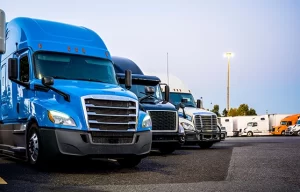Crafting and implementing business plans amidst a pandemic has posed significant challenges for numerous operators. As vaccination rates approach the thresholds set for the anticipated 'reopening' of the country, a sense of relief is likely to be felt among business owners, particularly those in the trucking and transport industry. To stay ahead of the curve when transitioning into yet another iteration of the 'new normal', it's opportune to contemplate initiating strategies for capitalizing on new vehicle investments.
So how can the latest economic indicators assist business operators with their investment plans? What do the experts and analysts see ahead on the road for the Australian economy? What could all this mean for your business and your truck purchasing plans? There was an increase in GDP for the June quarter yet some are talking recession. We attempt to unpack some of the commentary and the facts around the release of the latest National Accounts figures.
National Accounts June Quarter
During the period when the two most populous states in Australia were grappling with COVID-19 lockdowns, Treasurer Josh Frydenberg unveiled the national accounts for the June Quarter. These figures revealed a 0.7% growth in the economy during the June 2021 quarter. The Treasurer highlighted that this result exceeded market expectations and surpassed budget forecasts.
Frydenberg emphasized that these statistics underscore the economy's resilience and should instill confidence in a post-restriction recovery. Although the figures only cover up until June 2021 and don't account for the extended lockdowns in NSW and Victoria, the Treasurer acknowledged that some form of lockdown was in effect for 29 days of the quarter.
Key observations include a 1.1% surge in household consumption and a 2.3% increase in new business investments. Robust investment in equipment and machinery continued, propelled by the Government's temporary full expensing and loss carry back incentives. Notably, GDP in the agricultural sector experienced a 1.5% expansion during the quarter, marking a remarkable 48.3% increase over the same period in 2020.
This data pertains to the June quarter and predates the extended lockdowns. Looking forward, the immediate future, as reflected in the September quarter figures, mirrors our present circumstances. However, due to the lag in releasing national accounts data, the true impact of the lockdowns won't be evident until the September quarter figures are unveiled in early December. Many analysts and economists are forecasting a potential 4% decline in GDP for the September quarter. Despite predictions, the Australian economy's performance has consistently defied expectations over the past year, often surpassing even the Treasurer's own budget forecasts.
The Treasurer acknowledged the challenges posed by the upcoming September quarter figures. Nonetheless, he expressed optimism that once restrictions are lifted, the final stretch leading up to the end of the year, the December quarter, will usher in a rebound for the economy.
So what of the talk of recession from some voices? Recession is a technically classified as a decrease in GDP over two consecutive quarters as was experienced in Australia in 2020. With the two biggest state economies in lockdown in the September quarter, it is expected that the period will record a negative growth figure. While those figures won’t be known till December and then the December quarter figures not till March 2022, business owners don’t need an economist to tell them what business conditions they are operating in right now.
Amidst border restrictions, health directives affecting workers and businesses in the designated NSW Local Government Areas of concern, and the perplexing regulations faced by interstate truck drivers, numerous operators are grappling with significant difficulties and frustrations. However, several sectors appear to be performing strongly and unveiling potential opportunities for the future.
It's worth keeping a close eye on global supply chain challenges, as they could impact certain businesses. This issue has persisted throughout the global pandemic, with the shortage of computer chips significantly affecting the production of various parts, machinery, vehicles, and other essential components.
Sectors to Watch
Examining growth trends in pivotal sectors can prove valuable when evaluating the prospect of investing in new vehicles. Notably, the rural sector has experienced expansion, while the construction sector has also made substantial contributions to the overall positive growth figures.
Infrastructure continues to be strong with governments at all levels proceeding with plans set out in various budgets over the past year. For those reliant on large infrastructure projects, we note that Infrastructure Australia is calling for a rethink of infrastructure policy in its latest statement. This is an independent advisory body that provides a roadmap and recommendations for key sectors. Could be worth reviewing and taking note of for your forward planning.
The traditional bricks-and-mortar retail sector is facing challenges, yet recent data reveals that online shopping sales have reached unprecedented levels, marking a new peak. Sales have been so robust that Australia Post even had to temporarily halt collections from certain online sellers in certain regions to manage a backlog of deliveries. These developments serve as positive signs for those engaged in the general delivery sector.
Truck Investments: Finance and Interest Rates
Sales in trucks have been good in recent reporting periods, which is highly likely an indication of the take-up of the government investment incentives. For those that are yet to take advantage of temporary full expensing, it’s worth mentioning that this initiative is still on the table for eligible businesses.
To qualify, the assets, such as the truck, must be utilized within the business before the 30th of June, 2022, to be deductible in the 2021-2022 business financials. This scheme remains accessible until the 30th of June, 2023, for inclusion in the 2022/23 accounts. This initiative offers numerous appealing advantages to businesses, as detailed in several articles. Incorporating it into your business strategy for the future is certainly worthwhile.
Lending interest rates continue to remain in the historic low range and it is expected that despite the June quarter increase in GDP, that the RBA will hold rates at current levels in coming periods. This means we continue to be in a position to offer cheaper truck loan interest rates across our truck loan products. To assist with your business investment plans, contact us to discuss a quote for finance on a new truck purchase.
Contact Jade Truck Loans on 1300 000 003 to discuss all forms of truck finance.
DISCLAIMER: THIS INFORMATION IS ISSUED PURELY FOR THE PURPOSE OF GENERAL INFORMATION PROVISION. IT IS NOT TO BE TAKEN AS THE ONLY SOURCE OF INFORMATION FOR BASING FINANCIAL DECISION-MAKING. THOSE REQUIRING FINANCIAL GUIDANCE AND ADVICE SHOULD CONSULT WITH THEIR FINANCIAL CONSULTANT OR ADVISOR. NO LIABILITY IS ACCEPTED FOR ANY MISREPRESENTATION OF POLICIES, DATA OR ERRORS IN THIS CONTENT.


 " alt="">
" alt="">